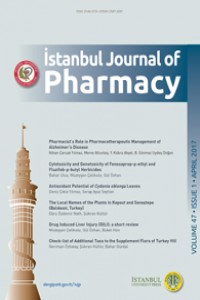Abstract
Objective of this study was to determine the total polyphenol content, antioxidant activity properties of the methanolic, ethanolic and aqueous extracts of Cydonia oblonga Miller leaves. Quince leaves have been used as folk medicine in Turkey. Total polyphenol content was determined by Folin–Ciocalteu assay. The antioxidant capacity was determined by ferric ion reducing antioxidant power method (FRAP) and DPPH (2, 2-diphenyl-1 picryl hydrazyl) free radical scavenging method by spectrophotometry. The methanol extract had the highest total phenolic content and the highest antioxidant activity. The results demonstrated that the correlation between total polyphenol content and antioxidant activity which was measured by DPPH and FRAP assays was positive and quince leaves are cheap and natural sources of antioxidants.
References
- Benzie IF, Strain JJ (1999). Ferric reducing/antioxidant power assay: direct measure of total antioxidant activity of biological fluids and modified version for simultaneous measurement of total antioxidant power and ascorbic acid concentration. Methods Enzymol 299: 15-27. [CrossRef ] • Cerempei A, Mureşan EI, Cimpoeşu N, Carp-Carare C, Rimbu C (2016). Dyeing and antibacterial properties of aqueous extracts from quince (Cydonia oblonga) leaves. Ind Crops Prod 94: 216-225. [CrossRef ] • Davis PH (1972). Flora of Turkey and East Aegean Islands. Vol. 4. Edinburgh University Press, Edinburgh, pp. 157. • Fu L, Xu B, Xu X, Gan R, Zhang Y, Xia E, Li H (2011). Antioxidant capacities and total phenolic contents of 62 fruits. Food Chem 129: 345–350. [CrossRef ] • Karaçelik AA, Küçük M, İskefiyeli Z, Aydemir S, De Smet S, Miserez B, Sandra P (2015). Antioxidant components of Viburnum opulus L. determined by on-line HPLC–UV–ABTS radical scavenging and LC– UV–ESI-MS methods. Food Chem 175: 106-114. [CrossRef ] • Marinova G, Batchvarov V (2011). Evaluation of the methods for determination of the free radical scavenging activity by DPPH. Bulg J Agric Sci 17: 11-24. • Pacifico S, Gallicchio M, Fiorentino A, Fischer A, Meyer U, Stintzing FC (2012). Antioxidant properties and cytotoxic effects on human cancer cell lines of aqueous fermented and lipophilic quince (Cydonia oblonga Mill.) preparations. Food Chem Toxicol 50: 4130-4135. [CrossRef] • Ayaz Seyhan S, Yalçın G, Çıkla Yılmaz D, Demirbağ Ç (2013). Türkiye’de yetişen nar, yaban mersini ve ürünlerinde antioksidan kapasite tayini ve yöntemlerin kromatografik olarak incelenmesi (SAG-A-131113-0423). Prepared for Marmara University BAPKO Projects, İstanbul. • Slinkard K, Singleton VL (1977). Total phenol analysis: Automation and comparison with manual methods. Am J Enol Vitic 28: 49–55. • Teleszko M, Wojdylo A (2015). Comparison of phenolic compounds and antioxidant potential between selected edible fruits and their leaves. J Funct Foods 14: 736-746. [CrossRef ] • Tuzlacı E (2006). Şifa Niyetine Türkiye’nin Bitkisel Halk İlaçları. Alfa Yayınları, İstanbul, pp. 91-93. • Zengin G, Çakmak YS, Aktümsek A (2010). In vitro antioxidant capacities and fatty acid compositions of three Centaurea species collected from Central Anatolia region of Turkey. Food Chem Toxicol 48: 2638-2641. [CrossRef ] • Karadag A, Ozcelik B, Saner S (2009). Review of methods to determine antioxidant capacities. Food Anal Method 2: 41–60. [CrossRef ]
Abstract
References
- Benzie IF, Strain JJ (1999). Ferric reducing/antioxidant power assay: direct measure of total antioxidant activity of biological fluids and modified version for simultaneous measurement of total antioxidant power and ascorbic acid concentration. Methods Enzymol 299: 15-27. [CrossRef ] • Cerempei A, Mureşan EI, Cimpoeşu N, Carp-Carare C, Rimbu C (2016). Dyeing and antibacterial properties of aqueous extracts from quince (Cydonia oblonga) leaves. Ind Crops Prod 94: 216-225. [CrossRef ] • Davis PH (1972). Flora of Turkey and East Aegean Islands. Vol. 4. Edinburgh University Press, Edinburgh, pp. 157. • Fu L, Xu B, Xu X, Gan R, Zhang Y, Xia E, Li H (2011). Antioxidant capacities and total phenolic contents of 62 fruits. Food Chem 129: 345–350. [CrossRef ] • Karaçelik AA, Küçük M, İskefiyeli Z, Aydemir S, De Smet S, Miserez B, Sandra P (2015). Antioxidant components of Viburnum opulus L. determined by on-line HPLC–UV–ABTS radical scavenging and LC– UV–ESI-MS methods. Food Chem 175: 106-114. [CrossRef ] • Marinova G, Batchvarov V (2011). Evaluation of the methods for determination of the free radical scavenging activity by DPPH. Bulg J Agric Sci 17: 11-24. • Pacifico S, Gallicchio M, Fiorentino A, Fischer A, Meyer U, Stintzing FC (2012). Antioxidant properties and cytotoxic effects on human cancer cell lines of aqueous fermented and lipophilic quince (Cydonia oblonga Mill.) preparations. Food Chem Toxicol 50: 4130-4135. [CrossRef] • Ayaz Seyhan S, Yalçın G, Çıkla Yılmaz D, Demirbağ Ç (2013). Türkiye’de yetişen nar, yaban mersini ve ürünlerinde antioksidan kapasite tayini ve yöntemlerin kromatografik olarak incelenmesi (SAG-A-131113-0423). Prepared for Marmara University BAPKO Projects, İstanbul. • Slinkard K, Singleton VL (1977). Total phenol analysis: Automation and comparison with manual methods. Am J Enol Vitic 28: 49–55. • Teleszko M, Wojdylo A (2015). Comparison of phenolic compounds and antioxidant potential between selected edible fruits and their leaves. J Funct Foods 14: 736-746. [CrossRef ] • Tuzlacı E (2006). Şifa Niyetine Türkiye’nin Bitkisel Halk İlaçları. Alfa Yayınları, İstanbul, pp. 91-93. • Zengin G, Çakmak YS, Aktümsek A (2010). In vitro antioxidant capacities and fatty acid compositions of three Centaurea species collected from Central Anatolia region of Turkey. Food Chem Toxicol 48: 2638-2641. [CrossRef ] • Karadag A, Ozcelik B, Saner S (2009). Review of methods to determine antioxidant capacities. Food Anal Method 2: 41–60. [CrossRef ]
Details
| Subjects | Pharmacology and Pharmaceutical Sciences |
|---|---|
| Journal Section | Original Article |
| Authors | |
| Publication Date | October 10, 2017 |
| Submission Date | October 10, 2017 |
| Published in Issue | Year 2017 Volume: 47 Issue: 1 |

